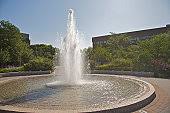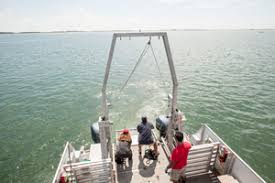


Ground Water
The Clean Water Act regulates any discharges to ground water. To help protect our ground water and to help Stony Brook University comply with The Clean Water Act, Environmental Health and Safety has the responsibility to oversee Stony Brook University's State Pollution Discharge Elimination System (SPDES) Permit. Some of the responsibilities include, but are not limited to:
- Monthly sampling to check discharges to groundwater.
- Regular inspections of the recharge basins for a visible sheen of oil.
- Periodic short-term extensive testing when required.
- Working with facility operations to reduce the discharge of pollutants and recommending the use of secondary containment for any hazard that could discharge to groundwater.
- Cleaning oil or chemical spills that could reach the storm drains.
- Keeping information on SPDES permit up-to-date and modifying our permit as required
- Installing ground water monitoring wells at strategic locations around campus.
- Overseeing the biannual sampling of ground water monitoring wells by contractor.
- Monthly visual checks of ground water at monitoring wells.
How can you help?
- Never dispose of hazardous materials by dumping them outside.
- Always use secondary containment for hazardous materials that could discharge to storm drains (even road salt needs to be stored under cover.)
- Never change your oil or antifreeze on campus.
- Clean-up oil or chemical spills that could reach the storm drains.
- Report any oil or antifreeze leaks to University Police (631) 632-3333 or Environmental Health and Safety at (631) 632-6410.
- Use fertilizer with lower levels of nitrogen on your lawn
- Remember that water discharging to our storm drains will become our drinking water in the future.
Surface Water
The Clean Water Act also regulates any discharges to surface water. Sanitary wastes are discharged to the Suffolk County Department of Public Works (SCDPW) sewage treatment plant located near the north entrance to campus. Effluent from this plant is discharged to the Long Island Sound via the Port Jefferson treatment plant.
What are Environmental Health and Safety's responsibilities?
To help protect the waters of our community and to help Stony Brook University comply with The Certificate to Discharge issued by the SCDPW, Environmental Health and Safety:
- Works with the campus community to reduce the discharge of pollutants and recommends the use of secondary containment for any hazard that could discharge to the sanitary sewer system.
- Cleans oil or chemical spills that could reach the sanitary sewer system.
- Takes a positive approach with regulators and works with SCDPW to track-down and eliminate unlawful discharges.
- Keeps information on Discharge Certificate up-to-date and modifies our certificate as required.
- Promotes waste reduction programs that also include water conservation.
How can you help?
- Never dispose of hazardous materials by dumping them down the drain.
- Always use secondary containment for hazardous materials that could discharge to the sanitary sewer system.
- Clean-up oil or chemical spills that could reach the sanitary sewer system.
- Remember that the sewage treatment plant can only treat sanitary waste not hazardous materials.
- Acids and bases can upset the treatment plant by killing the bio organisms.
- Heavy metals can concentrate in the sludge, making it a hazardous waste
- Solvents can pose a hazard to the workers at the plant, and they also pass through untreated into the Long Island Sound.
- Detergents, soaps and wetting agents cause foaming in the aeration tank that upsets the treatment plant.
- Use organic fertilizer and pesticides and only apply at the recommended amounts.
- Yard waste left for pick-up should be bagged at the curb and not left loose in the gutter where it can wash into the storm drains.
- Increase street sweeping to keep sand and dirt from being washed away into stormwater runoff.
- Adopt and enforce erosion and sediment control for new developments and install stormwater controls.
Drinking Water
Stony Brook University is located above the aquifer that is the source for Long Island's drinking water. The Suffolk County Department of Public Works (SCDPW) monitors drinking water quality and maintains the safe standards for water provided to Stony Brook University.
What are Environmental Health and Safety's responsibilities?
To help protect Long Island's sole-source aquifer and to help Suffolk County DPW provide safe drinking water to the campus community. Environmental Health and Safety is responsible to:
- Work with Facility Services to ensure back flow prevention devices are used and maintained for any connection to SCDPW water lines.
- Protect the ground water by complying with the requirements of its SPDES permit.
- Maintain records for the amount of well water that is used for noncontact cooling water. This water is nonpotable and should not be used for drinking water.
- Work with facility operations to reduce the discharge of pollutants and recommend the use of secondary containment for any hazard that could discharge to groundwater.
- Cleaning oil or chemical spills that could reach the storm drains.
How can you help?
- Never dispose of hazardous materials by dumping them outside.
- Always use secondary containment for hazardous materials that could discharge to ground water.
- Clean-up oil or chemical spills that could reach groundwater.
- Report any chemical spills to University Police (631) 632-3333 or Environmental Health and Safety at (631) 632-6410.
- Remember that water discharging to groundwater will become our drinking water in the future.
